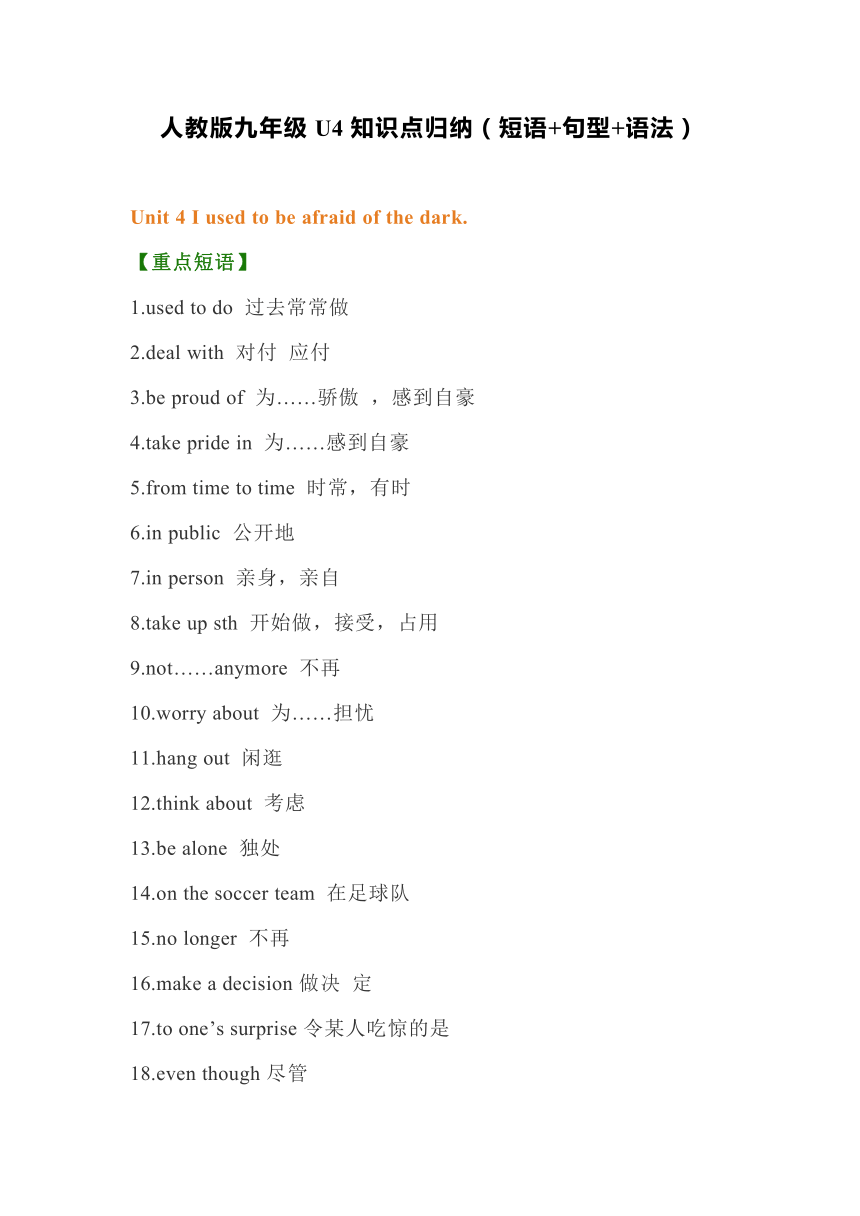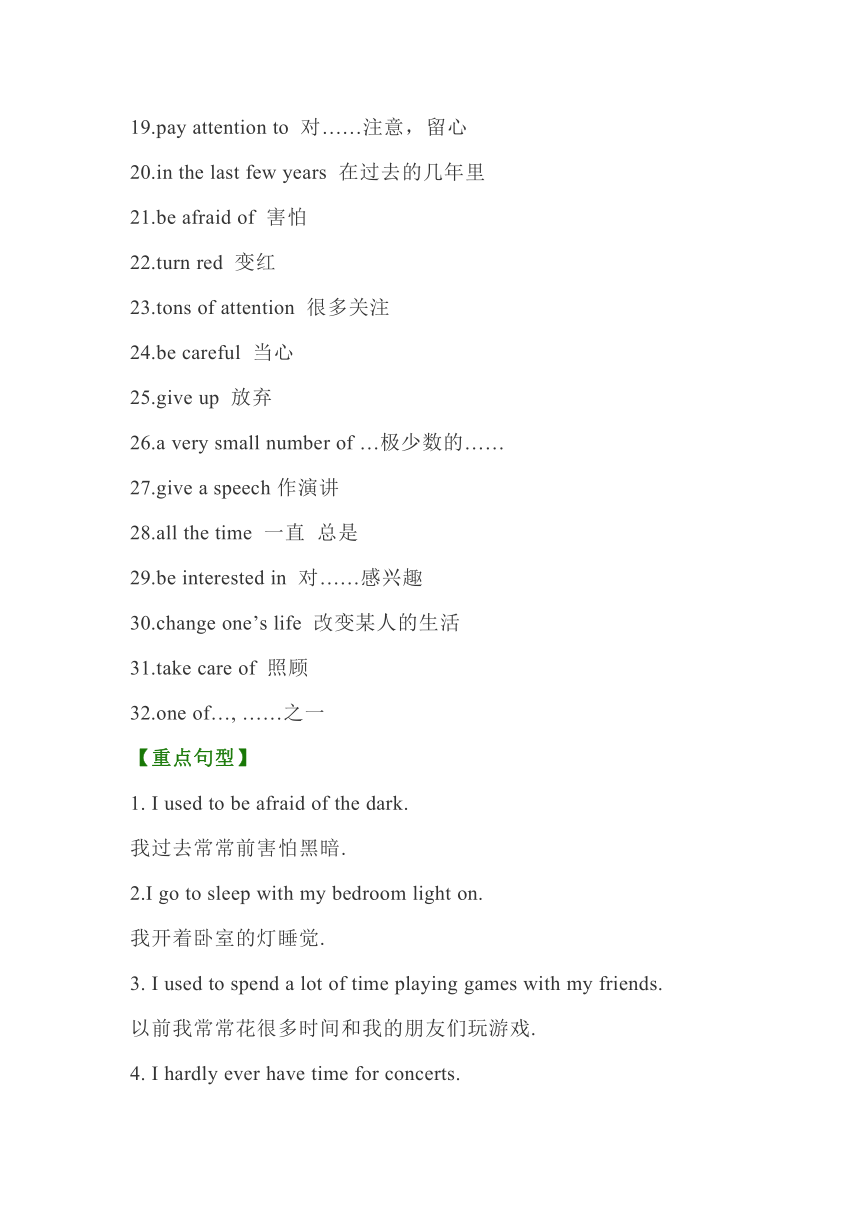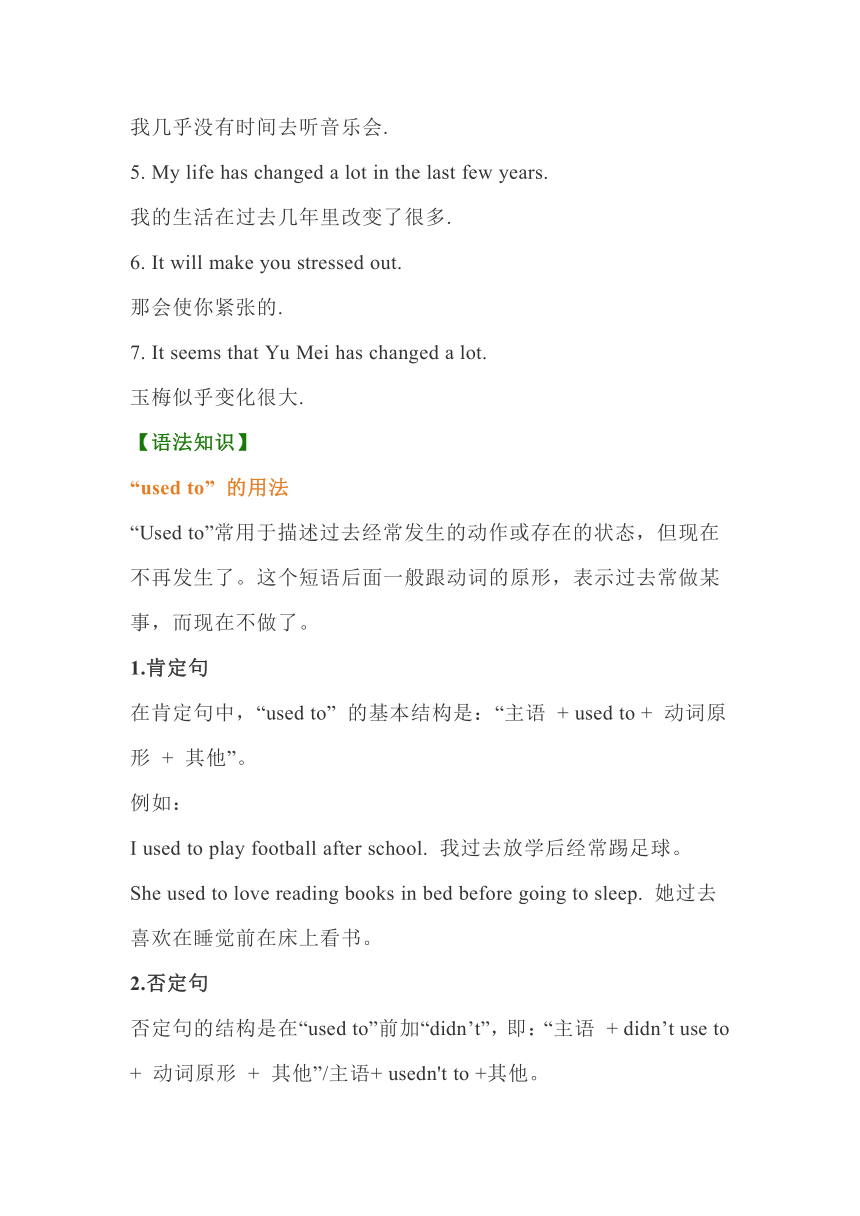Unit 4 I used to be afraid of the dark知识点归纳(短语+句型+语法)
文档属性
| 名称 | Unit 4 I used to be afraid of the dark知识点归纳(短语+句型+语法) |  | |
| 格式 | docx | ||
| 文件大小 | 21.2KB | ||
| 资源类型 | 教案 | ||
| 版本资源 | 人教新目标(Go for it)版 | ||
| 科目 | 英语 | ||
| 更新时间 | 2024-09-20 15:07:26 | ||
图片预览



文档简介
人教版九年级U4知识点归纳(短语+句型+语法)
Unit 4 I used to be afraid of the dark.
【重点短语】
1.used to do 过去常常做
2.deal with 对付 应付
3.be proud of 为……骄傲 ,感到自豪
4.take pride in 为……感到自豪
5.from time to time 时常,有时
6.in public 公开地
7.in person 亲身,亲自
8.take up sth 开始做,接受,占用
9.not……anymore 不再
10.worry about 为……担忧
11.hang out 闲逛
12.think about 考虑
13.be alone 独处
14.on the soccer team 在足球队
15.no longer 不再
16.make a decision 做决 定
17.to one’s surprise 令某人吃惊的是
18.even though 尽管
19.pay attention to 对……注意,留心
20.in the last few years 在过去的几年里
21.be afraid of 害怕
22.turn red 变红
23.tons of attention 很多关注
24.be careful 当心
25.give up 放弃
26.a very small number of …极少数的……
27.give a speech 作演讲
28.all the time 一直 总是
29.be interested in 对……感兴趣
30.change one’s life 改变某人的生活
31.take care of 照顾
32.one of…, ……之一
【重点句型】
1. I used to be afraid of the dark.
我过去常常前害怕黑暗.
2.I go to sleep with my bedroom light on.
我开着卧室的灯睡觉.
3. I used to spend a lot of time playing games with my friends.
以前我常常花很多时间和我的朋友们玩游戏.
4. I hardly ever have time for concerts.
我几乎没有时间去听音乐会.
5. My life has changed a lot in the last few years.
我的生活在过去几年里改变了很多.
6. It will make you stressed out.
那会使你紧张的.
7. It seems that Yu Mei has changed a lot.
玉梅似乎变化很大.
【语法知识】
“used to” 的用法
“Used to”常用于描述过去经常发生的动作或存在的状态,但现在不再发生了。这个短语后面一般跟动词的原形,表示过去常做某事,而现在不做了。
1.肯定句
在肯定句中,“used to” 的基本结构是:“主语 + used to + 动词原形 + 其他”。
例如:
I used to play football after school. 我过去放学后经常踢足球。
She used to love reading books in bed before going to sleep. 她过去喜欢在睡觉前在床上看书。
2.否定句
否定句的结构是在“used to”前加“didn’t”,即:“主语 + didn’t use to + 动词原形 + 其他”/主语+ usedn't to +其他。
例如:
I didn’t use to watch TV every day. 我过去不是每天都看电视。
They didn’t use to go to the movies on weekends. 他们过去周末不去看电影。
3.疑问句
疑问句有两种形式:一般疑问句和反义疑问句。
1)一般疑问句:将“did”置于句首,并将主语和“used to”的顺序颠倒,结构为:“Did + 主语 + use to + 动词原形 + 其他 ”/Used+主语+to+其他。
肯定回答:Yes,主语+did
否定回答:No,主语+didn't
例如:
Did you use to play the piano 你过去经常弹钢琴吗
Did he use to be a teacher 他过去是老师吗
2)反义疑问句:在陈述句后加上一个简短的疑问句,用于确认信息。结构可以是“主语 + used to + 其它,didn’t + 主语 ”或“主语 + used to + 其它,usedn’t + 主语 ”。
例如:
She used to study hard, didn’t she 她过去学习很努力,不是吗
Tom used to tell jokes, usedn’t he 汤姆过去爱讲笑话,不是吗
当然,我将根据图片中给出的“used”的不同用法,结合我的专业知识,为大家详细讲解这个重要的英语语法点。我们将不仅复习图片中的内容,还会添加新的例句和知识点,以帮助大家更好地理解和运用“used”的各种用法。
4.“used ”的几种用法
1. used to do sth. 过去常常做某事
这个结构用于描述过去经常性或习惯性的动作,但现在不再发生了。它构成了英语的“一般过去时”的一种特殊用法。
例句:
I used to wake up early and read a book before breakfast. 我过去常常在早餐前早起读书。
She used to play basketball every Saturday, but now she prefers hiking. 她过去每个星期六都打篮球,但现在她更喜欢徒步旅行。
2. be/get used to doing sth. 习惯于做某事
这里,“to”是介词,后面跟名词、动名词或代词作为宾语。这个结构表达的是现在或未来的习惯。
例句:
After a few weeks, I got used to studying online. 几个星期后,我习惯了在线学习。
We are all used to working from home now because of the pandemic. 由于疫情,我们现在都习惯了在家工作。
注意:区别“used to”和“be/get used to”的关键在于时态和语义。“Used to”表示过去的习惯,而“be/get used to”则表示现在的习惯或适应性。
3. be used to do sth. 被用来做某事
这里的“to”是不定式符号,引导动词原形,表示被动语态中的动作目的或结果。
例句:
These knives are used to cut vegetables. 这些刀被用来切蔬菜。
In ancient times, books were used to store knowledge by writing on animal skins. 古时候,人们将知识写在动物皮上制成书籍以保存。
4. There used to be sth. + 地点 某地过去常常有某物
这个结构用来描述过去某个地方存在的某种事物或情况,但现在已经不存在了。
例句:
There used to be a beautiful garden behind our house, but now it's a parking lot. 我们家后面过去有一个美丽的花园,但现在是一个停车场了。
There used to be a cinema in this shopping mall, but it closed down years ago. 这个购物中心过去有一家电影院,但几年前就关闭了。
Unit 4 I used to be afraid of the dark.
【重点短语】
1.used to do 过去常常做
2.deal with 对付 应付
3.be proud of 为……骄傲 ,感到自豪
4.take pride in 为……感到自豪
5.from time to time 时常,有时
6.in public 公开地
7.in person 亲身,亲自
8.take up sth 开始做,接受,占用
9.not……anymore 不再
10.worry about 为……担忧
11.hang out 闲逛
12.think about 考虑
13.be alone 独处
14.on the soccer team 在足球队
15.no longer 不再
16.make a decision 做决 定
17.to one’s surprise 令某人吃惊的是
18.even though 尽管
19.pay attention to 对……注意,留心
20.in the last few years 在过去的几年里
21.be afraid of 害怕
22.turn red 变红
23.tons of attention 很多关注
24.be careful 当心
25.give up 放弃
26.a very small number of …极少数的……
27.give a speech 作演讲
28.all the time 一直 总是
29.be interested in 对……感兴趣
30.change one’s life 改变某人的生活
31.take care of 照顾
32.one of…, ……之一
【重点句型】
1. I used to be afraid of the dark.
我过去常常前害怕黑暗.
2.I go to sleep with my bedroom light on.
我开着卧室的灯睡觉.
3. I used to spend a lot of time playing games with my friends.
以前我常常花很多时间和我的朋友们玩游戏.
4. I hardly ever have time for concerts.
我几乎没有时间去听音乐会.
5. My life has changed a lot in the last few years.
我的生活在过去几年里改变了很多.
6. It will make you stressed out.
那会使你紧张的.
7. It seems that Yu Mei has changed a lot.
玉梅似乎变化很大.
【语法知识】
“used to” 的用法
“Used to”常用于描述过去经常发生的动作或存在的状态,但现在不再发生了。这个短语后面一般跟动词的原形,表示过去常做某事,而现在不做了。
1.肯定句
在肯定句中,“used to” 的基本结构是:“主语 + used to + 动词原形 + 其他”。
例如:
I used to play football after school. 我过去放学后经常踢足球。
She used to love reading books in bed before going to sleep. 她过去喜欢在睡觉前在床上看书。
2.否定句
否定句的结构是在“used to”前加“didn’t”,即:“主语 + didn’t use to + 动词原形 + 其他”/主语+ usedn't to +其他。
例如:
I didn’t use to watch TV every day. 我过去不是每天都看电视。
They didn’t use to go to the movies on weekends. 他们过去周末不去看电影。
3.疑问句
疑问句有两种形式:一般疑问句和反义疑问句。
1)一般疑问句:将“did”置于句首,并将主语和“used to”的顺序颠倒,结构为:“Did + 主语 + use to + 动词原形 + 其他 ”/Used+主语+to+其他。
肯定回答:Yes,主语+did
否定回答:No,主语+didn't
例如:
Did you use to play the piano 你过去经常弹钢琴吗
Did he use to be a teacher 他过去是老师吗
2)反义疑问句:在陈述句后加上一个简短的疑问句,用于确认信息。结构可以是“主语 + used to + 其它,didn’t + 主语 ”或“主语 + used to + 其它,usedn’t + 主语 ”。
例如:
She used to study hard, didn’t she 她过去学习很努力,不是吗
Tom used to tell jokes, usedn’t he 汤姆过去爱讲笑话,不是吗
当然,我将根据图片中给出的“used”的不同用法,结合我的专业知识,为大家详细讲解这个重要的英语语法点。我们将不仅复习图片中的内容,还会添加新的例句和知识点,以帮助大家更好地理解和运用“used”的各种用法。
4.“used ”的几种用法
1. used to do sth. 过去常常做某事
这个结构用于描述过去经常性或习惯性的动作,但现在不再发生了。它构成了英语的“一般过去时”的一种特殊用法。
例句:
I used to wake up early and read a book before breakfast. 我过去常常在早餐前早起读书。
She used to play basketball every Saturday, but now she prefers hiking. 她过去每个星期六都打篮球,但现在她更喜欢徒步旅行。
2. be/get used to doing sth. 习惯于做某事
这里,“to”是介词,后面跟名词、动名词或代词作为宾语。这个结构表达的是现在或未来的习惯。
例句:
After a few weeks, I got used to studying online. 几个星期后,我习惯了在线学习。
We are all used to working from home now because of the pandemic. 由于疫情,我们现在都习惯了在家工作。
注意:区别“used to”和“be/get used to”的关键在于时态和语义。“Used to”表示过去的习惯,而“be/get used to”则表示现在的习惯或适应性。
3. be used to do sth. 被用来做某事
这里的“to”是不定式符号,引导动词原形,表示被动语态中的动作目的或结果。
例句:
These knives are used to cut vegetables. 这些刀被用来切蔬菜。
In ancient times, books were used to store knowledge by writing on animal skins. 古时候,人们将知识写在动物皮上制成书籍以保存。
4. There used to be sth. + 地点 某地过去常常有某物
这个结构用来描述过去某个地方存在的某种事物或情况,但现在已经不存在了。
例句:
There used to be a beautiful garden behind our house, but now it's a parking lot. 我们家后面过去有一个美丽的花园,但现在是一个停车场了。
There used to be a cinema in this shopping mall, but it closed down years ago. 这个购物中心过去有一家电影院,但几年前就关闭了。
同课章节目录
- Unit 1 How can we become good learners.
- Section A
- Section B
- Unit 2 I think that mooncakes are delicious!
- Section A
- Section B
- Unit 3 Could you please tell me where the restroom
- Section A
- Section B
- Unit 4 I used to be afraid of the dark.
- Section A
- Section B
- Unit 5 What are the shirts made of?
- Section A
- Section B
- Review of Units 1-5
- Unit 6 When was it invented?
- Section A
- Section B
- Unit 7 Teenagers should be allowed to choose their
- Section A
- Section B
- Unit 8 It must belong to Carla.
- Section A
- Section B
- Unit 9 I like music that I can dance to.
- Section A
- Section B
- Unit 10 You're supposed to shake hands.
- Section A
- Section B
- Review of Units 6-10
- Unit 11 Sad movies make me cry.
- Section A
- Section B
- Unit 12 Life is full of the unexpected
- Section A
- Section B
- Unit 13 We're trying to save the earth!
- Section A
- Section B
- Unit 14 I remember meeting all of you in Grade 7.
- Section A
- Section B
- Review of Units 11-14
